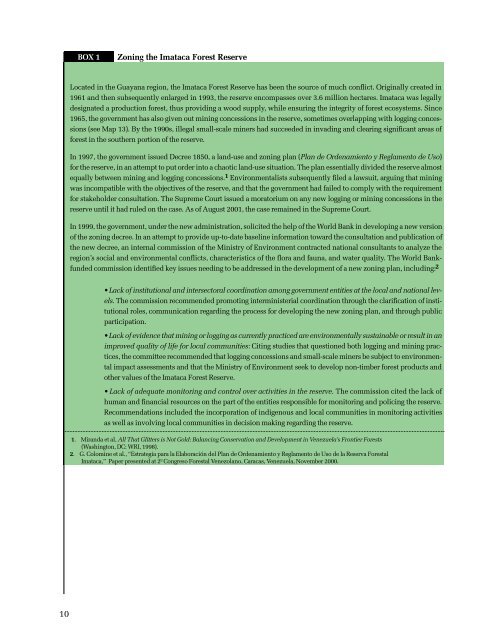Usar pâgs xvii-134 - ResearchGate
Usar pâgs xvii-134 - ResearchGate
Usar pâgs xvii-134 - ResearchGate
You also want an ePaper? Increase the reach of your titles
YUMPU automatically turns print PDFs into web optimized ePapers that Google loves.
BOX 1Zoning the Imataca Forest ReserveLocated in the Guayana region, the Imataca Forest Reserve has been the source of much conflict. Originally created in1961 and then subsequently enlarged in 1993, the reserve encompasses over 3.6 million hectares. Imataca was legallydesignated a production forest, thus providing a wood supply, while ensuring the integrity of forest ecosystems. Since1965, the government has also given out mining concessions in the reserve, sometimes overlapping with logging concessions(see Map 13). By the 1990s, illegal small-scale miners had succeeded in invading and clearing significant areas offorest in the southern portion of the reserve.In 1997, the government issued Decree 1850, a land-use and zoning plan (Plan de Ordenamiento y Reglamento de Uso)for the reserve, in an attempt to put order into a chaotic land-use situation. The plan essentially divided the reserve almostequally between mining and logging concessions. 1 Environmentalists subsequently filed a lawsuit, arguing that miningwas incompatible with the objectives of the reserve, and that the government had failed to comply with the requirementfor stakeholder consultation. The Supreme Court issued a moratorium on any new logging or mining concessions in thereserve until it had ruled on the case. As of August 2001, the case remained in the Supreme Court.In 1999, the government, under the new administration, solicited the help of the World Bank in developing a new versionof the zoning decree. In an attempt to provide up-to-date baseline information toward the consultation and publication ofthe new decree, an internal commission of the Ministry of Environment contracted national consultants to analyze theregion’s social and environmental conflicts, characteristics of the flora and fauna, and water quality. The World Bankfundedcommission identified key issues needing to be addressed in the development of a new zoning plan, including: 2• Lack of institutional and intersectoral coordination among government entities at the local and national levels.The commission recommended promoting interministerial coordination through the clarification of institutionalroles, communication regarding the process for developing the new zoning plan, and through publicparticipation.• Lack of evidence that mining or logging as currently practiced are environmentally sustainable or result in animproved quality of life for local communities: Citing studies that questioned both logging and mining practices,the committee recommended that logging concessions and small-scale miners be subject to environmentalimpact assessments and that the Ministry of Environment seek to develop non-timber forest products andother values of the Imataca Forest Reserve.• Lack of adequate monitoring and control over activities in the reserve. The commission cited the lack ofhuman and financial resources on the part of the entities responsible for monitoring and policing the reserve.Recommendations included the incorporation of indigenous and local communities in monitoring activitiesas well as involving local communities in decision making regarding the reserve.1. Miranda et al, All That Glitters is Not Gold: Balancing Conservation and Development in Venezuela’s Frontier Forests(Washington, DC: WRI, 1998).2. G. Colomine et al., “Estrategia para la Elaboración del Plan de Ordenamiento y Reglamento de Uso de la Reserva ForestalImataca,” Paper presented at 2º Congreso Forestal Venezolano, Caracas, Venezuela, November 2000.10
















